Search results for: 'Cotton fil'
- Related search terms
- film
- FILM MA
- FILLING MACHI
- filling mach
- filling machine d
-
 YY-2402 SEMI-AUTOMATIC PRODUCTION LINE FOR ROUND COTTON PADSYY-2402 SEMI-AUTOMATIC PRODUCTION LINE FOR ROUND COTTON PADS PURPOSE OF MACHINE: THIS MACHINE CAN PRODUCE FACIAL COTTON PADS IN VARIOUS SHAPES OF COTTON PADS. FOR EACH DIFFERENT SHAPE OF SIZE, A SEPARATE TOOL IS NEEDED. QUANTITY: 1 Learn More
YY-2402 SEMI-AUTOMATIC PRODUCTION LINE FOR ROUND COTTON PADSYY-2402 SEMI-AUTOMATIC PRODUCTION LINE FOR ROUND COTTON PADS PURPOSE OF MACHINE: THIS MACHINE CAN PRODUCE FACIAL COTTON PADS IN VARIOUS SHAPES OF COTTON PADS. FOR EACH DIFFERENT SHAPE OF SIZE, A SEPARATE TOOL IS NEEDED. QUANTITY: 1 Learn More -
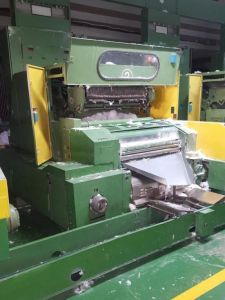 TT-1430 FALUBAZ LINE FOR THE PRODUCTION COSMETIC COTTON WOOL / ABSORBENT COTTON / COTTON / COTTON + VISCOSE, YEAR 1994TT-1430 FALUBAZ LINE FOR THE PRODUCTION COSMETIC COTTON WOOL / ABSORBENT COTTON / COTTON / COTTON + VISCOSE, YEAR 1994 PACKING MACHINE WITH TRANSPORTER FALUBAZ UK3 THE LINE IS AFTER GENERAL RENOVATION, IN VERY GOOD TECHNICAL CONDITION, STILL WORKING. QUANTITY: 1 PC Learn More
TT-1430 FALUBAZ LINE FOR THE PRODUCTION COSMETIC COTTON WOOL / ABSORBENT COTTON / COTTON / COTTON + VISCOSE, YEAR 1994TT-1430 FALUBAZ LINE FOR THE PRODUCTION COSMETIC COTTON WOOL / ABSORBENT COTTON / COTTON / COTTON + VISCOSE, YEAR 1994 PACKING MACHINE WITH TRANSPORTER FALUBAZ UK3 THE LINE IS AFTER GENERAL RENOVATION, IN VERY GOOD TECHNICAL CONDITION, STILL WORKING. QUANTITY: 1 PC Learn More -
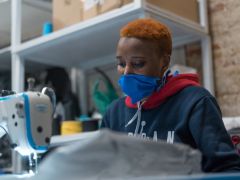 D-2388 What’s the Best Material for a Mask?
D-2388 What’s the Best Material for a Mask?Federal health officials have now recommended that we cover our faces with fabric during the coronavirus pandemic. But what material offers the most protection?
The Centers for Disease Control and Prevention has posted a no-sew mask pattern using a bandanna and a coffee filter as well as a video on making masks using rubber bands and folded fabrics found at home.
While a simple face covering can reduce the spread of coronavirus by blocking outgoing germs from coughs or sneezes of an infected person, experts say there is more variation in how much homemade masks might protect the wearer from incoming germs, depending on the fit and quality of the material used.
Scientists around the country have taken it upon themselves to identify everyday materials that do a better job of filtering microscopic particles. In recent tests, HEPA furnace filters scored well, as did vacuum cleaner bags, layers of 600-count pillowcases and fabric similar to flannel pajamas. Stacked coffee filters had medium scores. Scarves and bandanna material had the lowest scores, but still captured a small percentage of particles.
If you don’t have any of the materials that were tested, a simple light test can help you decide whether a fabric is a good candidate for a mask.
“Hold it up to a bright light,” said Dr. Scott Segal, chairman of anesthesiology at Wake Forest Baptist Health who recently studied homemade masks. “If light passes really easily through the fibers and you can almost see the fibers, it’s not a good fabric. If it’s a denser weave of thicker material and light doesn’t pass through it as much, that’s the material you want to use.”
Researchers say it’s important to remember that lab studies are conducted under perfect conditions with no leaks or gaps in the mask, but the test methods give us a way to compare materials. And while the degree of filtration for some homemade masks seems low, most of us — who are staying home and practicing social distancing in public — don’t need the high level of protection required for medical workers. More important, any face covering is better than none, especially if worn by a person who has the virus but doesn’t know it.
The biggest challenge of choosing a homemade mask material is to find a fabric that is dense enough to capture viral particles, but breathable enough that we can actually wear it. Some items being touted online promise high filtration scores, but the material would be unwearable.
Dressing Up for Work … at Home
Yang Wang, an assistant professor of environmental engineering at Missouri University of Science and Technology, worked with his graduate students to study various combinations of layered materials — including both air filters and fabric. “You need something that is efficient for removing particles, but you also need to breathe,” said Dr. Wang, who last fall won an international award for aerosol research.To test everyday materials, scientists are using methods similar to those used to test medical masks, which everybody agrees should be saved for medical workers who are exposed to high doses of virus from seeing infected patients. The best medical mask — called the N95 respirator — filters out at least 95 percent of particles as small as 0.3 microns. By comparison, a typical surgical mask — made using a rectangular piece of pleated fabric with elastic ear loops — has a filtration efficiency ranging from 60 to 80 percent.
Dr. Wang’s group tested two types of air filters. An allergy-reduction HVAC filter worked the best, capturing 89 percent of particles with one layer and 94 percent with two layers. A furnace filter captured 75 percent with two layers, but required six layers to achieve 95 percent. To find a filter similar to those tested, look for a minimum efficiency reporting value (MERV) rating of 12 or higher or a microparticle performance rating of 1900 or higher.
The problem with air filters is that they potentially could shed small fibers that would be risky to inhale. So if you want to use a filter, you need to sandwich the filter between two layers of cotton fabric. Dr. Wang said one of his grad students made his own mask by following the instructions in the C.D.C. video, but adding several layers of filter material inside a bandanna.
Dr. Wang’s group also found that when certain common fabrics were used, two layers offered far less protection than four layers. A 600 thread count pillow case captured just 22 percent of particles when doubled, but four layers captured nearly 60 percent. A thick woolen yarn scarf filtered 21 percent of particles in two layers, and 48.8 percent in four layers. A 100 percent cotton bandanna did the worst, capturing only 18.2 percent when doubled, and just 19.5 percent in four layers.
The group also tested Brew Rite and Natural Brew basket-style coffee filters, which, when stacked in three layers, showed 40 to 50 percent filtration efficiency — but they were less breathable than other options.
If you are lucky enough to know a quilter, ask them to make you a mask. Tests performed at the Wake Forest Institute for Regenerative Medicine in Winston-Salem, N.C., showed good results for homemade masks using quilting fabric. Dr. Segal, of Wake Forest Baptist Health, who led the study, noted that quilters tend to use high-quality, high-thread count cotton. The best homemade masks in his study were as good as surgical masks or slightly better, testing in the range of 70 to 79 percent filtration. Homemade masks that used flimsier fabric tested as low as 1 percent filtration, Dr. Segal said.
The best-performing designs were a mask constructed of two layers of high-quality, heavyweight “quilter’s cotton,” a two-layer mask made with thick batik fabric, and a double-layer mask with an inner layer of flannel and outer layer of cotton.
Bonnie Browning, executive show director for the American Quilter’s Society, said that quilters prefer tightly woven cottons and batik fabrics that stand up over time. Ms. Browning said most sewing machines can handle only two layers of fabric when making a pleated mask, but someone who wanted four layers of protection could wear two masks at a time.
Ms. Browning said she recently reached out to quilters on Facebook and heard from 71 people who have made a combined total of nearly 15,000 masks. “We quilters are very much in the thick of what’s going on with this,” said Ms. Browning, who lives in Paducah, Ky. “One thing most of us have is a stash of fabric.”
People who don’t sew could try a folded origami mask, created by Jiangmei Wu, assistant professor of interior design at Indiana University. Ms. Wu, who is known for her breathtaking folded artwork, said she began designing a folded mask out of a medical and building material called Tyvek, as well as vacuum bags, after her brother in Hong Kong, where mask wearing is common, suggested it. (DuPont, the maker of Tyvek, said in a statement that Tyvek is intended for medical apparel, not masks.) The folded mask pattern is free online, as is a video demonstrating the folding process. In tests at Missouri University and University of Virginia, scientists found that vacuum bags removed between 60 percent and 87 percent of particles. But some brands of vacuum bags may contain fiberglass or are harder to breathe through than other materials, and shouldn’t be used. Ms. Wu used a bag by EnviroCare Technologies, which has said it does not use fiberglass in its paper and synthetic cloth bags.
“I wanted to create an alternative for people who don’t sew,” said Ms. Wu, who said she is talking to various groups to find other materials that will be effective in a folded mask. “Given the shortage of all kinds of materials, even vacuum bags might run out.”
The scientists who conducted the tests used a standard of 0.3 microns because that is the measure used by the National Institute for Occupational Safety and Health for medical masks.
Linsey Marr, a Virginia Tech aerosol scientist and an expert in the transmission of viruses, said the certification method for respirators and HEPA filters focuses on 0.3 microns because particles around that size are the hardest to catch. While it seems counterintuitive, particles smaller than 0.1 microns are actually easier to catch because they have a lot of random motion that makes them bump into the filter fibers, she said.
“Even though coronavirus is around 0.1 microns, it floats around in a wide range of sizes, from around 0.2 to several hundred microns, because people shed the virus in respiratory fluid droplets that also contain lots of salts and proteins and other things,” said Dr. Marr. “Even if the water in the droplets fully evaporates, there’s still a lot of salt and proteins and other gunk that stays behind as solid or gel-like material. I think 0.3 microns is still useful for guidance because the minimum filtration efficiency will be somewhere around this size, and it’s what NIOSH uses.”
Learn More -
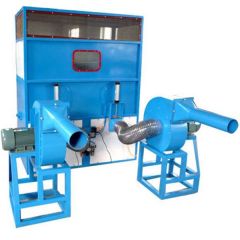 M-5004 PILLOW FILLING MACHINESREFERENCE NUMBER: M-5004 (1212CKWDHH11) L PILLOW FILLING MACHINES DIFFERENT CAPACITIES FOR THIS MACHINE 100KG/H, 120KG/H, 220KG/H, 250KG/H FUNCTION OF THE PILLOW FILLING MACHINE: THE SMALL PIECES OF RAW COTTON OPENING INTO A FLUFFY IMITATION SILK, COTTON, AND USED THE WIND SUCTION OUT FROM OPENING MACHINE, IMITATION SILK COTTON BY METAL DUCT INTO THE CUSHION OR PILLOW. OPERATOR CONTROL THE COTTON FILLING TIME. IT WILL CONNECT WITH THE FIBER OPENING MACHINE THE PRODUCTION LINE INCLUDES FIBER OPENING, CONVEYING, MIXED STIRRING AND STUFFING. IT MIXES AND STIRS MANY KINDS OF STUFFING MATERIALS AND THEN FILLS THEM INTO THROW PILLOWS, CUSHIONS, PILLOWS, PET PRODUCTS, BIG PLUSH TOYS, AND OTHERS. THE OPENING RATE OF THE MACHINE IS UP TO 100%, NO DAMAGES TO FIBER CRIMP AND SLIPPERY. THE STUFFED PRODUCT IS FLUFFY, ELASTIC, AND SOFT. REASONABLE AND EFFICIENT STRUCTURAL CONFIGURATION IMPROVES MANUFACTURING EFFICIENCY, SAVES COT FOR CUSTOMERS, AND DECREASES LABOR INTENSITY. ALL WORK TEETH ARE PROCESSED WITH DYNAMIC BALANCE, NO VIBRATION AND LOW NOISE IN THE OPERATION. THE MACHINE CAN BE FREELY COMBINED BASED ON CUSTOMER’S CHOICE OF AN OPENER AND A FILLING MACHINE, SATISFYING DIFFERENT CUSTOMER’S REQUIREMENTS. CE CERTIFICATION (MODEL: 001) PILLOW FILLING MACHINE CAPACITY: 100KG/H POWER: 6.7KW PRESSURE: 0.4 TO 0.8 MPA VOLTAGE: AS PER CUSTOMER REQUIREMENT NET WEIGHT: 680KG DIMENSION: 3200mm x 1500mm x 1330mm (MODEL: 002) PILLOW FILLING MACHINE CAPACITY: 120KG/H POWER: 6.7KW PRESSURE: 0.4 TO 0.8 MPA VOLTAGE: AS PER CUSTOMER REQUIREMENT NET WEIGHT: 700KG DIMENSION: 3500mm x 1500mm x 1330mm (MODEL: 003) PILLOW FILLING MACHINE CAPACITY: 220KG/H POWER: 10.45KW PRESSURE: 0.4 TO 0.8 MPA VOLTAGE: AS PER CUSTOMER REQUIREMENT NET WEIGHT: 900KG DIMENSION: 4000mm x 2200mm x 1200mm (MODEL: 004) PILLOW FILLING MACHINE CAPACITY: 250KG/H POWER: 10.45KW PRESSURE: 0.4 TO 0.8 MPA VOLTAGE: AS PER CUSTOMER REQUIREMENT NET WEIGHT: 1050KG DIMENSION: 4500mm x 2500mm x 2050mm QUANTITY AVAILABLE: 1 Learn More
M-5004 PILLOW FILLING MACHINESREFERENCE NUMBER: M-5004 (1212CKWDHH11) L PILLOW FILLING MACHINES DIFFERENT CAPACITIES FOR THIS MACHINE 100KG/H, 120KG/H, 220KG/H, 250KG/H FUNCTION OF THE PILLOW FILLING MACHINE: THE SMALL PIECES OF RAW COTTON OPENING INTO A FLUFFY IMITATION SILK, COTTON, AND USED THE WIND SUCTION OUT FROM OPENING MACHINE, IMITATION SILK COTTON BY METAL DUCT INTO THE CUSHION OR PILLOW. OPERATOR CONTROL THE COTTON FILLING TIME. IT WILL CONNECT WITH THE FIBER OPENING MACHINE THE PRODUCTION LINE INCLUDES FIBER OPENING, CONVEYING, MIXED STIRRING AND STUFFING. IT MIXES AND STIRS MANY KINDS OF STUFFING MATERIALS AND THEN FILLS THEM INTO THROW PILLOWS, CUSHIONS, PILLOWS, PET PRODUCTS, BIG PLUSH TOYS, AND OTHERS. THE OPENING RATE OF THE MACHINE IS UP TO 100%, NO DAMAGES TO FIBER CRIMP AND SLIPPERY. THE STUFFED PRODUCT IS FLUFFY, ELASTIC, AND SOFT. REASONABLE AND EFFICIENT STRUCTURAL CONFIGURATION IMPROVES MANUFACTURING EFFICIENCY, SAVES COT FOR CUSTOMERS, AND DECREASES LABOR INTENSITY. ALL WORK TEETH ARE PROCESSED WITH DYNAMIC BALANCE, NO VIBRATION AND LOW NOISE IN THE OPERATION. THE MACHINE CAN BE FREELY COMBINED BASED ON CUSTOMER’S CHOICE OF AN OPENER AND A FILLING MACHINE, SATISFYING DIFFERENT CUSTOMER’S REQUIREMENTS. CE CERTIFICATION (MODEL: 001) PILLOW FILLING MACHINE CAPACITY: 100KG/H POWER: 6.7KW PRESSURE: 0.4 TO 0.8 MPA VOLTAGE: AS PER CUSTOMER REQUIREMENT NET WEIGHT: 680KG DIMENSION: 3200mm x 1500mm x 1330mm (MODEL: 002) PILLOW FILLING MACHINE CAPACITY: 120KG/H POWER: 6.7KW PRESSURE: 0.4 TO 0.8 MPA VOLTAGE: AS PER CUSTOMER REQUIREMENT NET WEIGHT: 700KG DIMENSION: 3500mm x 1500mm x 1330mm (MODEL: 003) PILLOW FILLING MACHINE CAPACITY: 220KG/H POWER: 10.45KW PRESSURE: 0.4 TO 0.8 MPA VOLTAGE: AS PER CUSTOMER REQUIREMENT NET WEIGHT: 900KG DIMENSION: 4000mm x 2200mm x 1200mm (MODEL: 004) PILLOW FILLING MACHINE CAPACITY: 250KG/H POWER: 10.45KW PRESSURE: 0.4 TO 0.8 MPA VOLTAGE: AS PER CUSTOMER REQUIREMENT NET WEIGHT: 1050KG DIMENSION: 4500mm x 2500mm x 2050mm QUANTITY AVAILABLE: 1 Learn More -
 J-4564 5 KILO SAMPLE SOFT FLOW MACHINEJ-4564 5 KILO SAMPLE SOFT FLOW MACHINE CAPACITY 5 TO 10 KILO MATERIAL CONSTRUCTION [HTHP-VESSEL] 316 L 5 mm THICKNESS PUMP SS 316 – MOTOR HP 3 HP – 1500 RPM DIAMETER OF VESSEL 1150 mm TOTAL LENTGH 2200 mm TOTAL WIDTH 3900 mm MAXIMUM WORKING HIGH TEMP. 135° C MAXIMUM WORKING PRESSURE 3 KG/ cm2 TUBE 1 TUBE SIZE DIAMETER 200 mm NOZZLE SIZE [OVERFLOW FIX ] DIAMETER 190 mm X 168 mm INSIDE WINCH (HP) 1 HP X 1 FOR FULLY AUTO COLOR TANK INJECTION PUMP 1 HP/3000 RPM UNLOADING WINCH 1 HP /200RPM GEAR BOX COLOR TANK (LITERS) 20 LITERS X 2 PIECES FILL (AUTO) DIAMETER 1.5” X 2 DRAIN [ AUTO] DIAMETER 1.5 ” X 2 OVER FLOW [AUTO] DIAMETER 1.5” X 1 HEAT [ AUTO] DIAMETER 1” COOL [ AUTO] DIAMETER 1” LIQUOR RATIO 1: 5 TO 1 : 7 [ DEPEND ON FABRIC] QUANTITY: 1 Learn More
J-4564 5 KILO SAMPLE SOFT FLOW MACHINEJ-4564 5 KILO SAMPLE SOFT FLOW MACHINE CAPACITY 5 TO 10 KILO MATERIAL CONSTRUCTION [HTHP-VESSEL] 316 L 5 mm THICKNESS PUMP SS 316 – MOTOR HP 3 HP – 1500 RPM DIAMETER OF VESSEL 1150 mm TOTAL LENTGH 2200 mm TOTAL WIDTH 3900 mm MAXIMUM WORKING HIGH TEMP. 135° C MAXIMUM WORKING PRESSURE 3 KG/ cm2 TUBE 1 TUBE SIZE DIAMETER 200 mm NOZZLE SIZE [OVERFLOW FIX ] DIAMETER 190 mm X 168 mm INSIDE WINCH (HP) 1 HP X 1 FOR FULLY AUTO COLOR TANK INJECTION PUMP 1 HP/3000 RPM UNLOADING WINCH 1 HP /200RPM GEAR BOX COLOR TANK (LITERS) 20 LITERS X 2 PIECES FILL (AUTO) DIAMETER 1.5” X 2 DRAIN [ AUTO] DIAMETER 1.5 ” X 2 OVER FLOW [AUTO] DIAMETER 1.5” X 1 HEAT [ AUTO] DIAMETER 1” COOL [ AUTO] DIAMETER 1” LIQUOR RATIO 1: 5 TO 1 : 7 [ DEPEND ON FABRIC] QUANTITY: 1 Learn More -
 T-9895 FULLY AUTOMATIC MATTRESS (PET PAD) MAKING MACHINE, 120 TO 150 PIECES PER MINUTET-9895 FULLY AUTOMATIC MATTRESS (PET PAD) MAKING MACHINE, 120 TO 150 PIECES PER MINUTE TECHNICAL PARAMETERS FUNCTION: EMBOSSING, CUTTING, FOLDING OF PET PAD FOLDING METHOD: 1/3 IN THE WIDTH DIRECTION, 2 TIMES IN THE LENGTH DIRECTION RAW MATERIAL WIDTH: HYDROPHILIC CLOTH WIDTH ≦ 600mm (SLIGHTLY SMALLER THAN THE WIDTH OF THE CAST FILM) WATER ABSORPTION LAYER WIDTH = HYDROPHILIC CLOTH WIDTH: 50 TO 60mm CAST FILM WIDTH ≦ 600mm PRODUCT UNFOLDED SIZE: 400 X 600mm; 500 X 700mm; 600 X 900mm FOLDED SIZE: 135 X 200mm; 170 X 250mm; 200 X 300mm SPEED: 120 TO 150 PIECES PER MINUTE FINISHED PRODUCT LENGTH: LENGTH ERROR ≦ 5mm THE POSITION OF THE ABSORBENT LAYER: THE SAME LENGTH AS THE HYDROPHILIC CLOTH AND CAST FILM WATER-ABSORBING LAMINATED PATTERN: DIAMOND PATTERN (CUSTOMIZABLE) NUMBER OF FOLDING LAYERS: 3 LAYERS EACH FOLD WIDTH: 135 TO 200mm APPLICABLE RAW MATERIALS: HYDROPHILIC NON-WOVEN FABRIC ABOUT 20 GSM WATER ABSORPTION LAYER 0.5 TO 3mm CAST FILM ABOUT 25 GSM SSS SPUNBOND WEIGHT: 13 TO 15 GSM THE INNER DIAMETER OF THE RAW MATERIAL CORE: 3 INCHES (75mm) RAW MATERIAL DIAMETER: NON-WOVEN FABRIC ≦ 700mm WATER ABSORPTION LAYER ≦ 1200mm CAST FILM ≦ 400mm MACHINE SIZE (L X W X H) MACHINE: 15000 X 2000 X 1700mm VOLTAGE: 380V/50Hz POWER: 12KW (WITHOUT WOOD PULP SECTION) NET WEIGHT: 6T AIR COMPRESSOR: ≥ 0.6MPA 1.2m³/MINUTE, 15KW (CUSTOMER FURNISHES) NONWOVEN ROLL MAXIMUM DIAMETER: 650mm FILM ROLL DIAMETER: 450mm REQUIRES 2 40 FOOT HQ CONTAINERS Learn More
T-9895 FULLY AUTOMATIC MATTRESS (PET PAD) MAKING MACHINE, 120 TO 150 PIECES PER MINUTET-9895 FULLY AUTOMATIC MATTRESS (PET PAD) MAKING MACHINE, 120 TO 150 PIECES PER MINUTE TECHNICAL PARAMETERS FUNCTION: EMBOSSING, CUTTING, FOLDING OF PET PAD FOLDING METHOD: 1/3 IN THE WIDTH DIRECTION, 2 TIMES IN THE LENGTH DIRECTION RAW MATERIAL WIDTH: HYDROPHILIC CLOTH WIDTH ≦ 600mm (SLIGHTLY SMALLER THAN THE WIDTH OF THE CAST FILM) WATER ABSORPTION LAYER WIDTH = HYDROPHILIC CLOTH WIDTH: 50 TO 60mm CAST FILM WIDTH ≦ 600mm PRODUCT UNFOLDED SIZE: 400 X 600mm; 500 X 700mm; 600 X 900mm FOLDED SIZE: 135 X 200mm; 170 X 250mm; 200 X 300mm SPEED: 120 TO 150 PIECES PER MINUTE FINISHED PRODUCT LENGTH: LENGTH ERROR ≦ 5mm THE POSITION OF THE ABSORBENT LAYER: THE SAME LENGTH AS THE HYDROPHILIC CLOTH AND CAST FILM WATER-ABSORBING LAMINATED PATTERN: DIAMOND PATTERN (CUSTOMIZABLE) NUMBER OF FOLDING LAYERS: 3 LAYERS EACH FOLD WIDTH: 135 TO 200mm APPLICABLE RAW MATERIALS: HYDROPHILIC NON-WOVEN FABRIC ABOUT 20 GSM WATER ABSORPTION LAYER 0.5 TO 3mm CAST FILM ABOUT 25 GSM SSS SPUNBOND WEIGHT: 13 TO 15 GSM THE INNER DIAMETER OF THE RAW MATERIAL CORE: 3 INCHES (75mm) RAW MATERIAL DIAMETER: NON-WOVEN FABRIC ≦ 700mm WATER ABSORPTION LAYER ≦ 1200mm CAST FILM ≦ 400mm MACHINE SIZE (L X W X H) MACHINE: 15000 X 2000 X 1700mm VOLTAGE: 380V/50Hz POWER: 12KW (WITHOUT WOOD PULP SECTION) NET WEIGHT: 6T AIR COMPRESSOR: ≥ 0.6MPA 1.2m³/MINUTE, 15KW (CUSTOMER FURNISHES) NONWOVEN ROLL MAXIMUM DIAMETER: 650mm FILM ROLL DIAMETER: 450mm REQUIRES 2 40 FOOT HQ CONTAINERS Learn More -
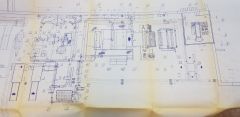 TT-2639 COMPLETE LINE FOR PROCESSING NON-WOVEN FABRIC, ROLLS WIDTH 30mm TO MAX 2200mmTT-2639 COMPLETE LINE FOR PROCESSING NON-WOVEN FABRIC, ROLLS WIDTH 30mm TO MAX 2200mm THERMOBOND LINE: POLYPROPYLENE POLYESTER POLYAMID, AND MIXTURES WITH VISCOSE OR COTTON TILL CA 30%. COVERSTOK, HYGIENE NONWOVEN FOR PADS, SLIPS, DRAPES GOWNS, FILTERS, WET WIPES, AUTOMOTIVE INDUSTRY, UPHOLSTERY TRUTZSCHLER, SPINNBAU, RAMISCH KLEINEWEFERS, EDELMAN TERMOBOND LINE INTENDED USE: NONWOVEN PRODUCTION FROM ALL SYNTHETIC FIBRES AND MIXTURES WITH SYNTHETIC FIBRES WHERE FIBRES SOFTENING POINT IS BELOW 250 OC. ROLLS WIDTH: 30mm TO MAX 2200mm ROLLS DIAMETER MAX 1000mm GRAMMAGES: 16 GSM TO MAX 70 GSM (DUPLEX 70 GSM) QUANTITY: 1 Learn More
TT-2639 COMPLETE LINE FOR PROCESSING NON-WOVEN FABRIC, ROLLS WIDTH 30mm TO MAX 2200mmTT-2639 COMPLETE LINE FOR PROCESSING NON-WOVEN FABRIC, ROLLS WIDTH 30mm TO MAX 2200mm THERMOBOND LINE: POLYPROPYLENE POLYESTER POLYAMID, AND MIXTURES WITH VISCOSE OR COTTON TILL CA 30%. COVERSTOK, HYGIENE NONWOVEN FOR PADS, SLIPS, DRAPES GOWNS, FILTERS, WET WIPES, AUTOMOTIVE INDUSTRY, UPHOLSTERY TRUTZSCHLER, SPINNBAU, RAMISCH KLEINEWEFERS, EDELMAN TERMOBOND LINE INTENDED USE: NONWOVEN PRODUCTION FROM ALL SYNTHETIC FIBRES AND MIXTURES WITH SYNTHETIC FIBRES WHERE FIBRES SOFTENING POINT IS BELOW 250 OC. ROLLS WIDTH: 30mm TO MAX 2200mm ROLLS DIAMETER MAX 1000mm GRAMMAGES: 16 GSM TO MAX 70 GSM (DUPLEX 70 GSM) QUANTITY: 1 Learn More -
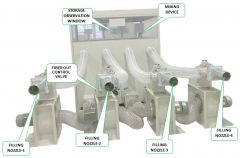 AA-1159 FOUR NOZZLES PILLOW FILLING PRODUCTION LINEAA-1159 FOUR NOZZLES PILLOW FILLING PRODUCTION LINE FOUR NOZZLES PILLOW FILLING MACHINE: IT IS SUITABLE FOR OPENING AND PROCESSING FIBER RAW MATERIAL, FILLING PILLOW CORE AND CUSHION. CHARACTERISTICS: LESS INVESTMENT, HIGH EFFICIENCY, SIMPLE OPERATION, WITH FREQUENCY CONVERSION DEVICE. RAW MATERIAL REQUIREMENTS: FIBERS ABOVE 0.78D, CAN BE OPENED AT ONE TIME. Learn More
AA-1159 FOUR NOZZLES PILLOW FILLING PRODUCTION LINEAA-1159 FOUR NOZZLES PILLOW FILLING PRODUCTION LINE FOUR NOZZLES PILLOW FILLING MACHINE: IT IS SUITABLE FOR OPENING AND PROCESSING FIBER RAW MATERIAL, FILLING PILLOW CORE AND CUSHION. CHARACTERISTICS: LESS INVESTMENT, HIGH EFFICIENCY, SIMPLE OPERATION, WITH FREQUENCY CONVERSION DEVICE. RAW MATERIAL REQUIREMENTS: FIBERS ABOVE 0.78D, CAN BE OPENED AT ONE TIME. Learn More -
 E-6016 TRUTZSCHLER PREPARATION LINE FOR COTTON FIBERSINVENTORY NUMBER: E-6016 TRUTZSCHLER PREPARATION LINE FOR COTTON FIBERS YEAR 2003 FOR SALE AS A COMPLETE PLANT ONLY TRUTZSCHLER COTTON PROCESSING MACHINE, C/O, MODEL SC 1552002 QUANTITY AVAILABLE: 1 Learn More
E-6016 TRUTZSCHLER PREPARATION LINE FOR COTTON FIBERSINVENTORY NUMBER: E-6016 TRUTZSCHLER PREPARATION LINE FOR COTTON FIBERS YEAR 2003 FOR SALE AS A COMPLETE PLANT ONLY TRUTZSCHLER COTTON PROCESSING MACHINE, C/O, MODEL SC 1552002 QUANTITY AVAILABLE: 1 Learn More -
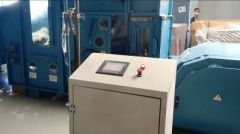 TT-2363 LION AUTOMATIC BLOWER, NOZZLES 2, YEAR 2011TT-2363 LION AUTOMATIC BLOWER, NOZZLES 2, YEAR 2011 QUANTITY: 1 Learn More
TT-2363 LION AUTOMATIC BLOWER, NOZZLES 2, YEAR 2011TT-2363 LION AUTOMATIC BLOWER, NOZZLES 2, YEAR 2011 QUANTITY: 1 Learn More
